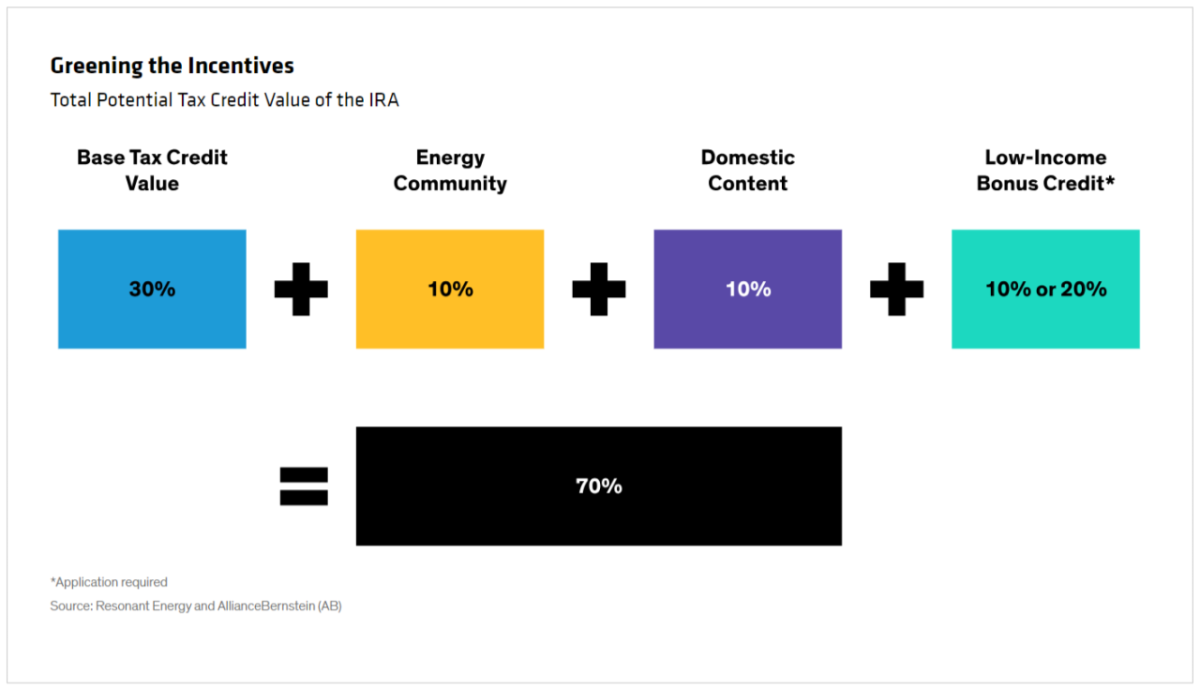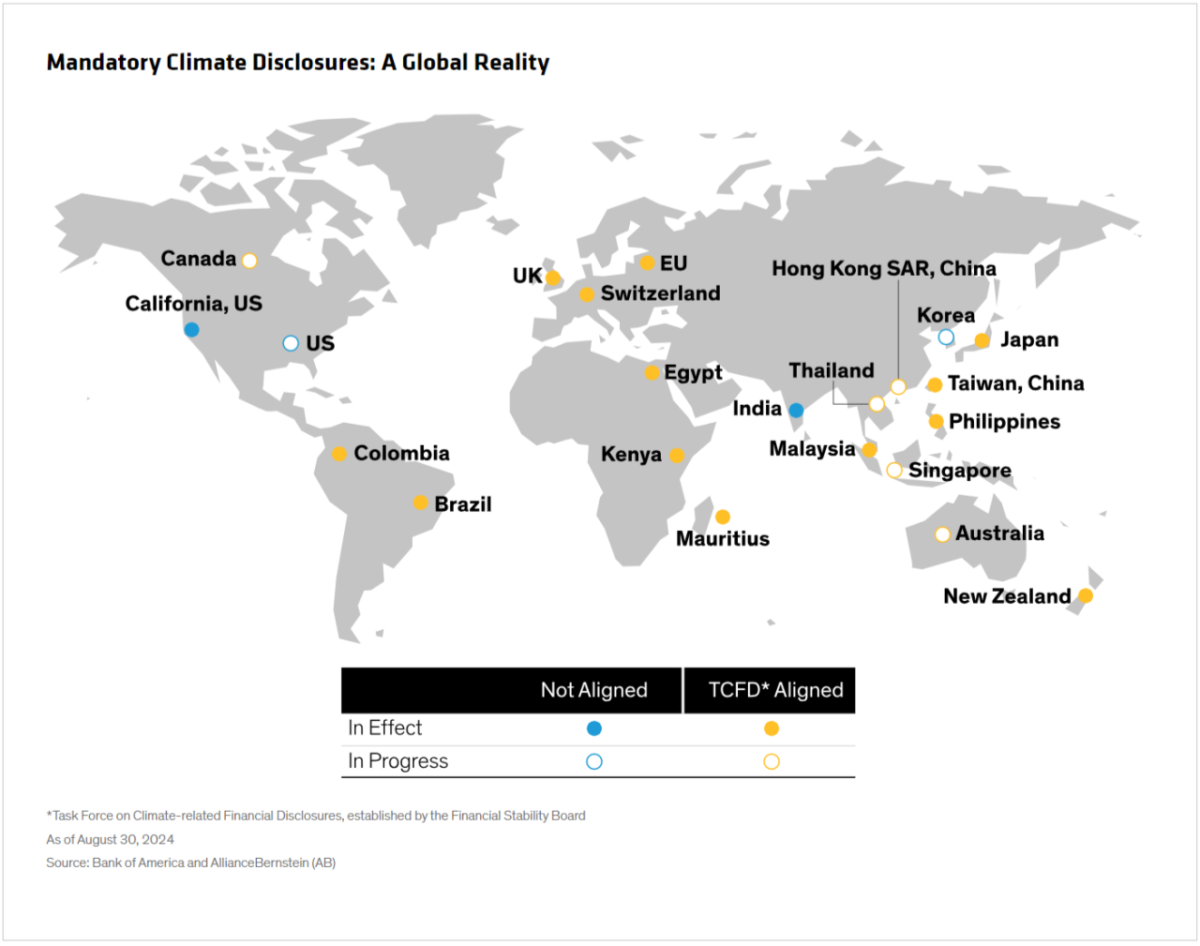AB: What Might US Elections Mean for Renewable Energy?
Xiaoyu Gu| Managing Director—AB CarVal
Kent Hargis, PhD| Chief Investment Officer—Strategic Core Equities; Portfolio Manager—Global Low Carbon Strategy
Kathleen Dumes, CFA| Responsible Investing Research Analyst—Fixed Income Responsible Investing
The case for renewables transcends politics.
The US Inflation Reduction Act has boosted investment opportunities in renewable energy. Could the potential for new leadership in Washington change that? We don’t think so.
In the two years since it became law, the IRA has intensified efforts to build renewable energy projects across the United States. It’s done this primarily by expanding federal tax credits for qualifying investments, including electric vehicles, solar and wind power generation, and the utility-scale batteries needed to store it.
The law passed in 2022 entirely with Democratic votes, and Republicans may attempt to roll back some of its provisions if they win Congress and the White House in November.
It’s About the Economics
We think a full IRA repeal is unlikely, and here’s why: the case for renewables and other private-sector energy management solutions is economic. Renewable energy fills a vital need for the US power grid, and at a lower cost than fossil fuels. What’s more, we think it could make the US economy stronger.
The transition away from fossil fuel isn’t new. It cuts across party lines, too. Annual US carbon emissions declined steadily from 2001 to 2022—a stretch during which both parties were in the White House. Crude oil and natural gas production grew over the same period, but so did clean-energy capacity.
And with the US, along with other countries, having pledged to meet net zero carbon emissions targets by 2050, we expect reliance on clean energy sources to increase regardless of election outcomes.
IRA Expanding Financial Incentives
Before the IRA, production and investment tax credits were limited to certain sectors—primarily wind and solar—and had to be renewed by Congress often.
The IRA extended the time frame for the credits by at least a decade, providing greater visibility for developers and investors. It also expanded the credits to more asset classes and, in some cases, provided more value. In some circumstances, credits may add up to more than half of the total cost (Display).
Even at today’s high interest rates, the tax credits are reducing construction costs for a range of renewable energy projects, including solar and wind power. They’re also widening return potential for public and private investors willing to fund those projects.
Where We See Investment Potential
A key area of focus involves updating the 60-year-old US power grid, which struggles to meet today’s electricity needs. Charging an electric car battery, for example, can pull up to 150 kilowatts from the grid—the equivalent of 1,500 100-watt lightbulbs—in less than an hour. Commercial, industrial and utility-scale battery storage assets help to meet increased electricity demand while also delivering other important services that can provide attractive opportunities for investors.
Perhaps the most important: batteries help keep grids stable and reliable by managing the distribution of electricity in real time. This helps prevent sudden surges in demand from events like storms or wildfires that can cause blackouts.
Batteries can also be an alternative to costly infrastructure investment. Adding one to an area where the grid is constrained can reduce power bottlenecks far more cost-effectively than building new transmission and distribution lines.
US banks are a key capital source for such massive infrastructure investments. But stricter regulations are creating opportunities for private lenders. We think the combination of tax credits and project-generated cash flow have the potential to deliver attractive returns to private credit investors who extend loans to solar and storage projects backed by collateral, or who help developers gain access to tax credits.
Opportunity Beyond Renewables
We also see public debt opportunities among utilities that need to finance grid updates with multiyear capital expenditure plans and in companies across industries that are issuing ESG-labeled bonds with more transparent structures, increasingly ambitious targets, and credible plans to meet them.
And renewables are only part of the story. Industrial companies today are striving to reduce emissions through efficient energy technologies, and we think low-carbon equity strategies may uncover opportunity in companies that aim to help others lower their carbon footprints. These include providers of the smart-grid technology used to build energy-efficient buildings and high-voltage cable manufacturers that help connect the grid to renewable power generation.
What Might Change—and What Probably Won’t
A Republican win in November could alter the investment opportunity set—and for a time increase uncertainty in the US. A new president may seek to change aspects of the law, such as EV subsidies, or use some of its unspent revenue to fund other priorities, such as boosting exports or cutting taxes.
But as we see it, the challenge of shoring up an overextended grid will persist no matter who’s governing, making an outright repeal of the IRA difficult for several reasons:
- Renewable energy jobs: In the IRA’s first year, 280 renewable energy projects were announced across 45 US states, representing about $280 billion in new investment, $225 billion of it in Republican districts, according to Goldman Sachs. This could create more than 150,000 new jobs, mostly in states that tend to vote Republican.
- Broad regional impact: The law’s potential impact across regions may explain why Republican lawmakers recently urged House leadership to preserve clean energy tax credits if House control changes hands. They’re seen as critical to driving investment as natural gas and coal plants are decommissioned by utilities striving to reach net zero greenhouse gas (GHG) emissions by 2050. Fossil fuel firms have also expressed interest in other projects supported by tax credits, including carbon emissions capture and green hydrogen.
- Global disclosure requirements: Even if the SEC climate disclosure rule were repealed, which we don’t think is likely, US companies would still have to comply with mandatory climate disclosure requirements in jurisdictions around the world (Display). Paring back the federal law wouldn’t do the same at the state level. Several states, led by California, require public companies to disclose GHG emissions and climate-related risk.
Election results typically have consequences for policy—and the upcoming US contest is no exception. But when it comes to investing in clean energy development, we don’t think the potential doomsday scenarios are particularly convincing.
The views expressed herein do not constitute research, investment advice or trade recommendations and do not necessarily represent the views of all AllianceBernstein portfolio-management teams. Views are subject to change over time.
Learn more about AB’s approach to responsibility here.




